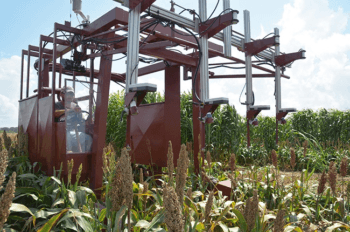Unmanned Aircraft, Ultrasonic Tech Powers Farmers To Higher Yields

It’s been said a picture is worth a thousand words. But for Dr. Seth Murray, the images captured by an unmanned aerial vehicle or self-propelled ground vehicle could be worth more than a thousand man hours.
The images can then lead to the selection of the next higher yielding crop variety, not in 10 years, but over two or three years.
Murray, a Texas A&M AgriLife corn breeder in the soil and crop science department of Texas A&M University at College Station, said the world of genomics and DNA markers has been around for 30 years, but only recently have they been routinely incorporated into the breeding programs.
Genomics allows researchers to identify genetic locations in plants exhibiting certain phenotypic traits they need to improve production.
But what is needed now is more development of high-throughput field phenotyping, or HTFP, tools for the next generation of plant breeding, Murray said.
Working with large teams of faculty, staff and students from across the Texas A&M system, he said his current project is to develop analysis methods and software that will allow HTFP data collection to aid in his breeding decisions.
“One of the big traits we are after is plant height in corn,” he said. “We spend three weeks with a crew of 10 people taking notes in the field, and one whole week of that is devoted to plant height.”
He explained that plant height in Texas corn is highly correlated to grain yield. Under the stressful field conditions of most Texas growers, taller corn seems to have higher vigor to resist those stresses. He cautioned that just selecting for tall plants would not improve yield, but it is one of many traits he uses.
To get the data that helps a breeder know which varieties are providing the necessary traits, measurements must be taken, Murray explained. Plant height is a primary and relatively straightforward example of a phenotype that could be automated by HTFP data collection.
The most promising tools to improve field-relevant phenotyping are systems that include sensors carried by ground vehicles or unmanned aerial vehicles, he said. Sensing data provides two major opportunities: to automate routine measurements in the field and to discover new phenotypes that were previously infeasible or impossible to collect.
Those personnel walking the fields must measure with sticks. But now there are sensors that can do that, he said. Currently, he is working with other researchers to test three different techniques: fixed-wing aircraft, a rotary copter aircraft and a ground vehicle.
“The first question now is can we use these images to replace the measurements we are already taking for height?” Murray said.
He said one of the problems right now is the unmanned aerial vehicle, or UAV, tools are targeted at hobbyists and growers and don’t necessarily work for the small plot work he as a plant breeder needs.
That is why the research and interaction of Texas A&M colleague’s from aerospace engineering, mechanical engineering, ecosystem science and management, agricultural engineering and geography in College Station as well as collaborating teams in Corpus Christi and Uvalde are vital.
“We have learned that even the commercial tools for growers are not yet ready for prime-time without some intellectual expertise,” he cautioned.
Continue reading on AgriLife Today.
This article by Kay Ledbetter originally appeared in AgriLife Today.





